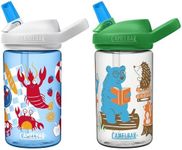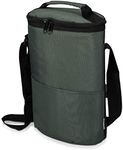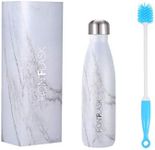Buying Guide for the Best Kids Water Bottles
Choosing the right water bottle for kids involves considering factors that ensure safety, convenience, and appeal to children. A good water bottle should be easy for kids to use, durable enough to withstand drops and bumps, and safe from harmful materials. Additionally, it should be easy to clean and maintain, as well as appealing in design to encourage kids to stay hydrated. Understanding the key specifications will help you make an informed decision that suits your child's needs and lifestyle.MaterialThe material of a kids' water bottle is crucial for safety and durability. Common materials include plastic, stainless steel, and glass. Plastic bottles are lightweight and often come in fun designs, but ensure they are BPA-free to avoid harmful chemicals. Stainless steel bottles are durable and can keep drinks cold or hot, but they are heavier. Glass bottles are safe and free from chemicals, but they can break easily. Choose a material based on your child's age, activity level, and your preference for safety and durability.
Size and CapacityThe size and capacity of a water bottle determine how much liquid it can hold and how easy it is for a child to carry. Smaller bottles (around 12-16 ounces) are suitable for younger children or short outings, while larger bottles (20-24 ounces) are better for older kids or longer activities. Consider your child's age, how much they drink, and the typical duration of their activities when selecting the right size.
Spout TypeThe spout type affects how easy it is for a child to drink from the bottle. Options include straw spouts, flip-top spouts, and screw-top lids. Straw spouts are great for younger kids as they are easy to use and spill-resistant. Flip-top spouts are convenient for quick access and are often found in sports bottles. Screw-top lids are more secure but may be harder for younger children to open. Choose a spout type that matches your child's age and ability to handle the bottle independently.
Leak-Proof DesignA leak-proof design is essential to prevent spills and messes, especially when the bottle is carried in a backpack. Look for bottles with secure seals and lids that close tightly. Some bottles have additional features like locking mechanisms to ensure they stay closed. Consider how the bottle will be used and where it will be stored to determine the importance of a leak-proof design for your needs.
Ease of CleaningEase of cleaning is important to maintain hygiene and ensure the bottle is safe for repeated use. Bottles with wide mouths are easier to clean, and those that are dishwasher safe offer added convenience. Some bottles have removable parts like straws or spouts that can be cleaned separately. Consider how often the bottle will be used and your cleaning preferences when choosing a bottle that is easy to maintain.
Design and ColorThe design and color of a water bottle can make it more appealing to children, encouraging them to use it regularly. Many bottles come in a variety of colors and feature popular characters or fun patterns. While this is a more subjective choice, involving your child in the selection process can ensure they are excited about their new bottle and more likely to use it. Consider your child's interests and preferences when choosing a design.

















